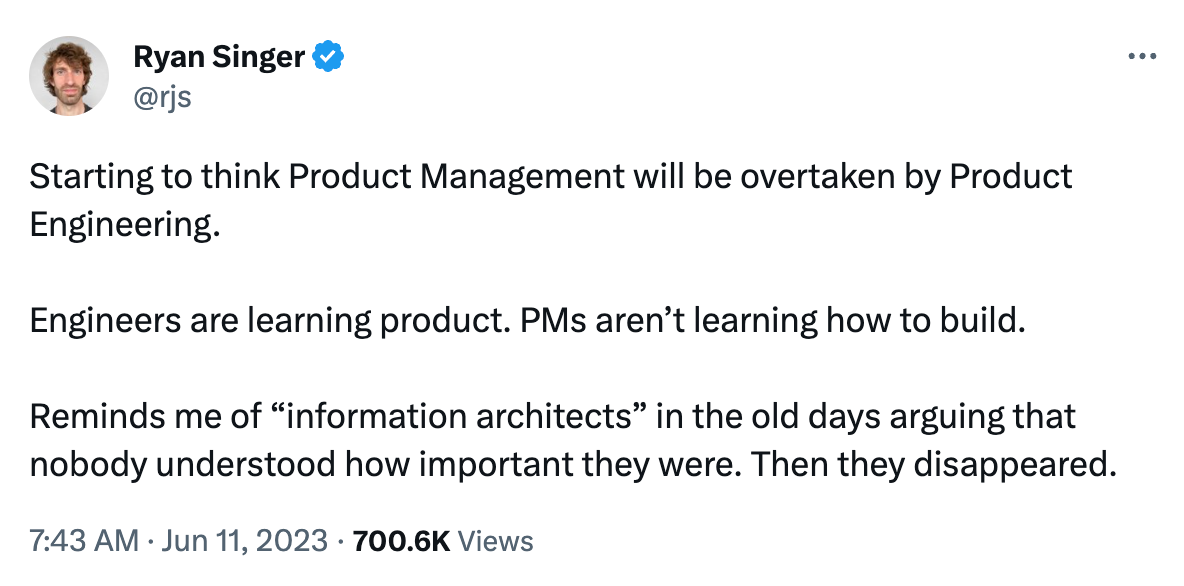- Published on
Most Product Management Isn't Product Management
- Authors
-
-

- Name
- Justin Hunter
- @polluterofminds
-
There’s a meme going around social media lately. When isn’t there a meme? This one, though, is particularly annoying because like most memes it intentionally misrepresents something but unlike most memes, it has the power to cause a negative change in the software industry.
The first I saw of the meme was (likely) an earnest observation from Ryan Singer (of Basecamp fame).
Since then, Brian Chesky of Airbnb was (largely incorrectly quoted) on the topic of the shifting nature of product management, thus amplifying the meme lords who were already latching onto Ryan’s tweet and bending it to express their frustration with how they either experience or their presumed experience of product management.
The context behind Chesky’s response here is that someone had already misinterpreted what he had said in a talk about how Airbnb was shifting the way they think about product management functions. You can see the actual comments Chesky made here.
Now, much of Twitter is piling on product management as if it is a useless function designed to slow engineers down. And I have news for everyone…
In a lot of cases, it is.
That’s because many companies aren’t actually practicing product management. Much of what we call product management is either a combination of busy work that used to be lumped in with project management or it is so siloed as to not be effective. Let’s dive into what is happening at these companies and why it feeds the meme. Then, we’ll explore what product management should be in high-functioning organizations.
A lot of product management is product ownership
As the software world shifted from waterfall to agile, there was a role that came along for the ride. It hitched itself to the product development process potentially out of fear that the process would fail without it. The role is called Product Owner. It’s a defined role within the Scrum agile process, but it also leads to confusion about product management.
I don’t mean to slight anyone in this role. There are a lot of really great people doing great work in this role. But the role itself assumes there is a need for someone to “own” the process of assigning tasks, moving tasks, following up on tasks, and more. The reason some people may think product management is a hindrance to execution is that those people aren’t closely involved with the “dirty work” of managing the workload.
This feeling that product managers are blockers is amplified in organizations that “empower” product managers to also be product owners. Such a process combines two roles and should, theoretically, give product managers more ownership over both the vision and the outcome. However, it leaves design and engineering behind. It pits other roles in direct opposition with the product manager because the product manager is the one defining and assigning.
This leads to the second big problem.
Lack of involvement
A team with all the context they need to do the job will always operate at a higher level than a team that receives orders and is told to execute. Unfortunately, many organizations do not allow product managers, developers, support, design, and sales to collaborate and build up a shared understanding of the context of their work. This results in everyone taking orders and executing toward some goal without understanding why.
An even more troubling part of the lack of context is when the product manager herself doesn’t even have the context. In that scenario, there is no opportunity for involvement. Yet even when the product manager has the context, organizational design can get in the way of pushing context and involvement across the chain.
Deep-seated fallacies also block progress on this front. Engineers who have never gotten on a customer call can sometimes be hesitant to join a product manager on a call. Designers who have traditionally operated in isolation may pull back when sales representatives provide feedback from their experience with prospects. The organizational inertia is towards isolation and not toward collaboration. This sets up a context barrier that leads to frustration.
What should product management look like?
In Tony Fadell’s fantastic book, Build, he talks about the point of product managers like this:
The majority of companies I work with misunderstand the role of the product manager—if they even know it exists. They think it’s marketing (nope), it’s project management (nope), it’s press relations/communications (nope), it’s design (nope), product finance (nope), it’s the founder or CEO’s job (not really).
This sums up everything I said in the preceding paragraphs in just a few lines. This is also what causes the memes on social media and the pile-on that happens after the memes are posted. A fundamental lack of understanding and proper implementation of the product manager role wreaks havoc in organizations.
Fadell goes on to compare the way organizations recognize product management as essentially the same as organizations recognized design in the 80s. They knew it was probably important, but didn’t understand why. So, if there’s such confusion about what product management is and how it should work, how can we hope to define it here?
The truth is, there probably will never be one definition. Product management is as fluid as the companies that hire for these roles. But we can arrive at general definitions of what product management should include.


